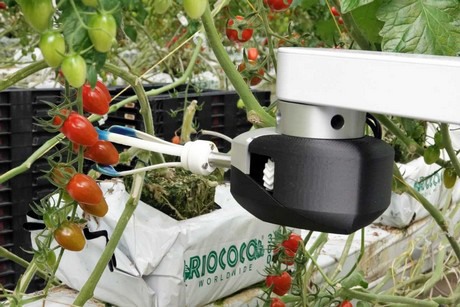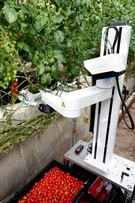With labor costs rising and a labor pool that is shrinking, growers are trying to find ways in which to keep their operations running smoothly and competitively. In response, a new industry has risen which is seeking to help the so-named “labor crisis” by developing new innovations. One of these innovations revolves around using robotics to automate some of the functions currently performed by workers.
Root AI, a Massachusetts-based company, has developed a robot capable of picking tomatoes by ripeness and quality. Josh Lessing, Root AI’s Co-Founder and CEO, says while the utilization of robotics isn’t new, the industry is now fine-tuning the technology, providing exciting opportunities for the produce industry.
“There has been a clear need for a robotic harvester for decades and tightening labor supply has only increased the necessity in recent years,” he said. “What makes today different, is that the technology has finally caught up and we can now develop compelling solutions for growers. We have been working on Virgo, which is our first harvesting product, for over a year now and it will be commercially deployed next year.”

How Virgo works
Root AI’s Virgo is described as an autonomous mobile robot that has been designed to pick fruit and vegetables. There are two advantages that makes Virgo different to other robotic equipment used in the produce industry. One is its ability to “see” fruit and determine whether it is ready to be picked. The other is the specially designed gripper which is able to handle produce delicately, thus avoiding damage to the product.
“Virgo is an autonomous mobile robot that uses 3D cameras, artificial-intelligence enabled reasoning and a dexterous gripper, to successfully replicate a person’s ability to identify and pick ripe fruit,” Lessing explained. “Virgo’s first application is picking tomatoes but we plan to expand the system's capabilities so it can help growers with other specialty crops like strawberries, cucumbers, and peppers. Moreover, by combining AI-based insights with delicate handling systems that physically care for each plant, we can empower growers to boost their yields while decreasing operational complexity and costs.”
Providing a dependable source of labor
As noted previously, the main aim of innovations like Virgo is to transform the labor segment of a producer’s operations. Root AI is aiming for Virgo to become a reliable labor source, one that not only can replicate a worker’s functions, but do so in a manner that is easy for the grower to manage as well.
 “Our core goal is to provide a scalable, high-quality and dependable source of labor, reducing one of the biggest challenges facing growers today,” Lessing shared. “Robots are predictable and reliable by design, making it easier to pick to a consistent ripeness, grade fruits for quality and prevent the spread of pests or diseases.”
“Our core goal is to provide a scalable, high-quality and dependable source of labor, reducing one of the biggest challenges facing growers today,” Lessing shared. “Robots are predictable and reliable by design, making it easier to pick to a consistent ripeness, grade fruits for quality and prevent the spread of pests or diseases.”
At the recent United Fresh show in Chicago, Root AI won the Innovation Award for the Best New Indoor Growing Technology. According to Lessing, the award is a demonstration that the company is on the right path. “The grower is at the center of every decision we make at Root AI, so it is incredibly rewarding to be recognized at United Fresh; it means that we are on track to make a meaningful impact with our technology.”
What next?
Now that Virgo has been developed and is undergoing testing, Root AI is planning on making it available to select partners in 2020 and more broadly in 2021. While the company is working on broader applications for Virgo when it comes to other produce, it is not going to stop there. The long-term goal is for Root AI to branch out to the broader spectrum of agtech innovations.”
“The harvesting robot is only the first step in a multi-pronged strategy to offer growers integrated ag-tech systems, with future products like disease detection and yield prediction,” Lessing concluded. “Ultimately, Root AI wants to be the global leader for intelligent agriculture solutions.”
For more information:
Josh Lessing
Root AI
jlessing@root-ai.com
www.root-ai.com
